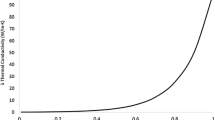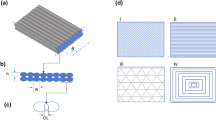Abstract
3D printing can be used to improve the geometric design of heat transfer structures by allowing the fabrication of more complex shapes which can enhance convective heat transfer; however, this can come at the expense of having a lower solid-phase thermal conductivity, especially when polymers are used. Improving the thermal conductivity of 3D-printed components has been the focus of many studies because of the potential to leverage additive manufacturing (AM) for thermal applications, such as heat exchangers. This study describes a fabrication process whereby 3D-printed polymer composites consisting of continuous metal wires and with enhanced effective thermal conductivity are fabricated using a modified fused filament fabrication (FFF) 3D printer. The wires were coextruded with the molten polymer through a modified hot end and nozzle assembly. The printed components have higher thermal conductivity than the base polymer because the wires create high thermal conductivity pathways in the printed rasters. Samples with different wire volume fractions, printing directions, and matrix materials were printed to investigate the effect of these parameters on the thermal conductivity of the printed composites. The thermal conductivity of the printed samples was evaluated experimentally using a steady-state measuring setup and analytically modeled using network thermal resistance models. The results show that 3D-printed continuous wire polymer composites can have a thermal conductivity as high as 9.4 W/mK using a volume fraction of 2.7% of continuous copper wires compared with 0.22 W/mK for the base polymer. Model results further demonstrate that usage of a higher volume fraction of conductive wires or other continuous conductive filler can further improve the thermal conductivity of these 3D-printed composites.












Similar content being viewed by others
References
Jafari D, Wits WW (2018) The utilization of selective laser melting technology on heat transfer devices for thermal energy conversion applications: a review. Renew Sustain Energy Rev 91(June):420–442. https://doi.org/10.1016/j.rser.2018.03.109
Deisenroth DC, Moradi R, Shooshtari AH, Singer F, Bar-Cohen A, Ohadi M (2018) Review of heat exchangers enabled by polymer and polymer composite additive manufacturing. Heat Transfer Eng 39(19):1648–1664. https://doi.org/10.1080/01457632.2017.1384280
Wang X, Jiang M, Zhou Z, Gou J, Hui D (2017) 3D printing of polymer matrix composites: a review and prospective. Compos Part B Eng 110:442–458
Kalsoom U, Nesterenko PN, Paull B (2016) Recent developments in 3D printable composite materials. RSC Adv 2016(6):60355–60371. https://doi.org/10.1039/C6RA11334F
Sa’ude N, Masood SH, Nikzad M, Ibrahim M, Ibrahim MHI (2013) Dynamic mechanical properties of Copper–ABS composites for FDM feedstock. Int J Eng Res Appl 3:1257–1263
Nikzad M, Masood SH, Sbarski I (2011) Thermo-mechanical properties of a highly filled polymeric composites for Fused Deposition Modeling. Mater Des 32(6):3448–3456
Masood SH, Song WQ (2004) Development of new metal/polymer materials for rapid tooling using Fused deposition modelling. Mater Des. https://doi.org/10.1016/j.matdes.2004.02.009
Masood SH, Song WQ (2005) Thermal characteristics of a new metal/polymer material for FDM rapid prototyping process. Assem Autom 25(4):309–315. https://doi.org/10.1108/01445150510626451
Hwang S, Reyes EI, Moon Ks et al (2015) Thermo-mechanical characterization of metal/polymer composite filaments and printing parameter study for fused deposition modeling in the 3D printing process. J Elec Mater 44:771–777. https://doi.org/10.1007/s11664-014-3425-6
Brenken B, Barocio E, Favaloro A, Kunc V, Pipes RB (2018) Fused filament fabrication of fiber-reinforced polymers: a review. Addit Manuf 21(January):1–16
Zhong W, Li F, Zhang Z, Song L, Li Z (2001) Short fiber reinforced composites for fused deposition modeling. Mater Sci Eng A 301(2):125–130. https://doi.org/10.1016/S0921-5093(00)01810-4
Ning F, Cong W, Hu Y, Wang H (2017) Additive manufacturing of carbon fiber-reinforced plastic composites using fused deposition modeling: effects of process parameters on tensile properties. J Compos Mater 51(4):451–462
Ivey M, Melenka GW, Carey JP, Ayranci C (2017) Characterizing short-fiber-reinforced composites produced using additive manufacturing. Adv Manuf Polym Compos Sci 3(3):81–91
Bagchi A, Nomura S (2006) On the effective thermal conductivity of carbon nanotube reinforced polymer composites. Compos Sci Technol. https://doi.org/10.1016/j.compscitech.2005.11.003
Lee GW, Lee JI, Lee SS et al (2005) Comparisons of thermal properties between inorganic filler and acid-treated multiwall nanotube/polymer composites. J Mater Sci 40:1259–1263. https://doi.org/10.1007/s10853-005-6947-8
Lee GW, Park M, Kim J, Lee JI, Yoon HG (2006) Enhanced thermal conductivity of polymer composites filled with hybrid filler. Compos Part A Appl Sci Manuf. https://doi.org/10.1016/j.compositesa.2005.07.006
Berman R (1976) Thermal conduction in solids. Clarendon press, Oxford
Chen H, Ginzburg VV, Yang J, Yang Y, Liu W, Huang Y, Du L, Chen B (2015) Thermal conductivity of polymer-based composites: fundamentals and applications. Prog Polym Sci 59:41–85
Prasher R (2009) Acoustic mismatch model for thermal contact resistance of van der Waals contacts. Appl Phys Lett 94(4):1–4
Pietrak K, Wiśniewski TS (2014) Methods for experimental determination of solid-solid interfacial thermal resistance with application to composite materials. J Power Technol 94(4):270–285
Ibrahim Y, Elkholy A, Schofield J, Melenka GW, Kempers R (2020) Effective thermal conductivity of 3D-printed continuous fiber polymer composites. Adv Manuf Polym Compos Sci 6:17–28
Ghosh B, Yousef W, Al Jaberi M, Al Hajeri N, Al Braiki A, Eveloy V, Rodgers P (2016) Design and investigation into the thermal and mechanical performance of a polymer composite prototype gas–liquid heat exchanger. Int J Thermal Environ Eng 11:51–59
Ibrahim Y, Melenka GW, Kempers R (2018) Additive manufacturing of continuous wire polymer composites. Manuf Lett 16(April):49–51
Ibrahim Y, Melenka GW, Kempers R (2018) Fabrication and tensile testing of 3D printed continuous wire polymer composites. RPJ 24:1131–1141. https://doi.org/10.1108/RPJ-11-2017-0222
Saleh M, Kempers R, Melenka GW (2019) 3D printed continuous wire polymer composites strain sensors for structural health monitoring. Smart Mater Struct 28:10541
Ibrahim Y, Kempers R, Amirfazli A (2019) “3D printed electro-thermal anti- or de-icing system for composite panels. Cold Reg Sci Technol 166:102844. https://doi.org/10.1016/j.coldregions.2019.102844
Elkholy A, Rouby M, Kempers R (2019) Characterization of the anisotropic thermal conductivity of additively manufactured components by fused filament fabrication. Prog Addit Manuf 4:497–515
MATWEB (2017) Material properties by MATWEB. Available: http://www.matweb.com. Accessed 11 Aug 2021
ASTM C1777 (2013) Standard test method for steady-state heat flux measurements and thermal transmission properties by means of the guarded-hot-plate. ASTM Int 2013:1–23. https://doi.org/10.1520/C0177-13.2”
Acknowledgements
The authors acknowledge the support of the Natural Sciences and Engineering Research Council of Canada (NSERC).
Funding
Natural Sciences and Engineering Research Council of Canada, grant no. RGPIN-2018-05879.
Author information
Authors and Affiliations
Corresponding author
Ethics declarations
Conflict of interest
On behalf of all authors, the corresponding author states that there is no conflict of interest.
Additional information
Publisher's Note
Springer Nature remains neutral with regard to jurisdictional claims in published maps and institutional affiliations.
Rights and permissions
About this article
Cite this article
Ibrahim, Y., Kempers, R. Effective thermal conductivity of 3D-printed continuous wire polymer composites. Prog Addit Manuf 7, 699–712 (2022). https://doi.org/10.1007/s40964-021-00256-5
Received:
Accepted:
Published:
Issue Date:
DOI: https://doi.org/10.1007/s40964-021-00256-5




